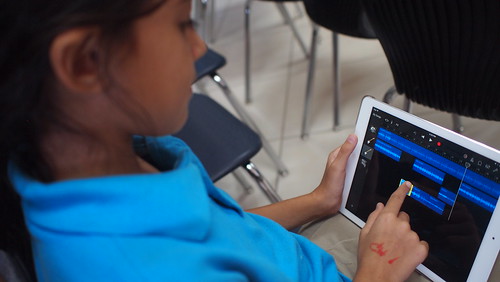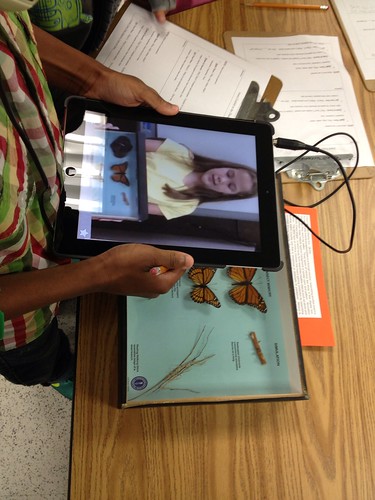Just like my peers – Erin, Jayme, Heidi, just to name a few – I had no idea what augmented reality and virtual reality were, nor what their applications in the classroom could be. When I first saw the topic during our first class this term, I too quickly glanced at it and then didn’t give it a second thought – it wasn’t something I was interested in pursuing. Just like Benita, I though these realities were for gamers, which immediately sent me in the other direction.
Boy, was I wrong.
Bill and Logan presented both virtual reality (VR) – a digitally projected world and reality – and augmented reality (AR) – putting something on top of the world we live in already – this week in class. The applications and integration possibilities are endless for the classroom – hands-on training for trades, simulated training, guided tour of the human body, field trips that wouldn’t be possible otherwise, interactive language-learning, and driver training practice, just to name a few. Just as Todd Nesloney and Drew Minock wrote in their blog post Augmented Reality Brings New Dimensions to Learning:
(P)rofound learning occurs when students create, share, interact and explain
AR and VR create the environment in which this can happen fruitfully and seamlessly – it all comes down to how creative you can be in your planning and lesson development. These realities present opportunities for authentic inquiry and active participation in the classroom, and align well with both situated and constructivist learning theories.

Photo Credit: flickingerbrad Flickr via Compfight cc
This does require us to wrap our head around what possibilities can be presented with these realities, and forces us to push open the box in which we normally find ourselves in the classroom. After having experienced both SkyView and Aurasma in class, and been presented with other VR and AR apps like Blippar and Anatomy 4D, it is easier to grasp different ways we can use this in the classroom.
Being a Social Studies teacher, my first thought was to travel the world to help students understand more clearly our past to truly comprehend the present. Wouldn’t it be great to see the Colosseum, the Acropolis, or Pompeii when you learn about them in Social 9? How about Florence, Versailles, or Paris when you speak of the Renaissance and the French Revolution in Social 10? How about visiting somber places of remembrance like Auschwitz or Juno Beach, or other historic monuments like the Berlin Wall when studying World War I, World War II, and the Cold War in Social 20? Let’s not forget how much impact it could have to see monuments like those at Vimy, Ypres, or Passchendaele when studying Canadian history in Social 30? It is not in the realm of possibility for most students to visit these places in their lives – and yet it would be much more powerful if they could, to truly understand our place in history. AR and VR bring this realm of impossibility to the forefront and change the way we view teaching in our schools. Just like Ashley shared in her blog this week, incorporating programs like Google Expeditions into the classroom could make these things happen – as well as interdisciplinary opportunities. While she could incorporate it in her technology classes, I could in my social studies lessons. The possibilities are endless.
Or so it seems.

Photo Credit: AleksGrynis Flickr via Compfight cc
What really gets me down is the cost. Although Google cardboard runs for about 20$, it still requires a device for it to function. Other companies selling AR or VR experiences, like Sony, HTC, and Oculus Rift run anywhere from 550-1150$. This really widens the digital divide we are already seeing in our classrooms – and makes it more difficult to develop AR/VR experiences in the classroom. In the post When Virtual Reality Meets Education, Elizabeth Reede and Larissa Bailiff speak to Pioneer Expeditions, an educational initiative from Google. In this program, schools will receive a kit for a virtual excursion for one day. These kids include smartphones, a tablet, a router, Google cardboard viewers or Mattel ViewMasters, and over 100 virtual trips for the taking. It is a fantastic opportunity for schools to experience an AR/VR tour, but as Adam remarked in his blog, it is expensive. It is not practical for a classroom to use consistently throughout the year. Wouldn’t it be great if this kit were something that could be repeated whenever the opportunity fit well within the curriculum and not simply for one day? I understand that one day is better than nothing, but it is disappointing that such a great educational endeavour becomes limited because of the cost and the requirement of resources. It is yet another demonstration of how education – a right in Canada – has a cost.
That being said, after experiencing Aurasma in class this week, I have been inspired to use it in my classroom in the coming weeks. At Campbell, every teacher has a CAP class – the Campbell Advisory Program. It is essentially homeroom – teachers have a group of students for fifteen minutes a day, every day, for four years. These students come from different elementary schools and are following completely different programs in high school. They do not know each other very well, and sometimes don’t even have another class with one another. So how can they get to know each other? Well I have taken pictures of every one of my CAP students and put it up in my class. I would love for them to record a short video describing themselves and their hobbies – similar to what we did at the start of this class with FlipGrid. These mini-biographies could be attached to their photo through the Aurasma app, and then other students could use this app to learn about their peers in the class. They could change their videos occasionally throughout the next four years, continually adapting their biographies to share with their peers. Additional information could be added throughout the year depending on our upcoming events – for example, we will be having a non-denominational gift exchange prior to Winter break. Students could share a list of things they would like to receive in the gift exchange in a short video that can be seen via Aurasma. A great way to limit paper usage but to share information consistently and continually throughout the years. I would love to try this in coming weeks – here’s to hoping it works!

Photo Credit: Barrett.Discovery Flickr via Compfight cc
What are your thoughts on AV/VR in the classroom? Have you used either? Do you think it widens or diminishes the digital divide in our society? Please let me know your thoughts below!

Hi Elizabeth, thanks for the interesting post. I think using Aurasma in your CAP class is a great idea. I agree that the cost of these technologies may be prohibitive. One thing I wonder though, is if eventually we will be able to completely replace textbooks with technology. I imagine that Google Cardboard, for instance, only costs a fraction of what one text would cost.
LikeLike
Pingback: Virtually endless possibilities! – Connections
What a fantastic idea for your CAP students to create auras about themselves. I really like that they can edit their auras, as needed, over the next four years. Brilliant! I’m trying out Aurasma with my grade 10 IP students. We are two days into the project… Hoping to record overlays tomorrow. There is no money in our school budget for expensive VR/AR, but I’m really hoping to give students the next best thing with apps like this!
LikeLike